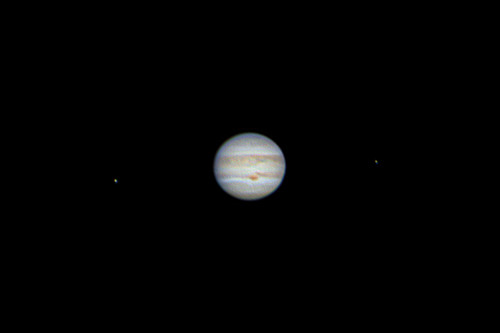18 – 19 August 2020, 22:00 – 00:30
Conditions: Mild to begin with, but started to turn chilly towards the end of the session. Patchy cloud passing overhead.
Seeing: Good
Transparency: Good
I began with a look at the two giant planets of the solar system (both of which are now one month after opposition). Jupiter’s Great Red Spot was visible, along with a very turbulent-looking NEB. Saturn could be seen casting a shadow across its rings and the Cassini Division was showing well. As the seeing was fairly good (considering Jupiter’s low altitude) I swapped the eyepiece for the Canon 80D and captured a few videos before the clouds got in the way.
I didn’t expect to get much else done tonight, so when the sky cleared again I decided to take a quick tour of some old favourites, as well as tracking down a couple of new targets.
Veil Nebula, supernova remnant, Cygnus
50x (24mm Panoptic) + OIII filter. Both sides of the loop and the inner triangle were visible, along with the “hooks” on the eastern veil. Like a lot of deep-sky objects, the more times you look at it, the easier it is to see the fainter details.
M31, Andromeda Galaxy
50x and 171x. Needs to be higher in the sky to get the best out of it, but the usual details were present and correct. Satellite galaxy M32 showed a star-like core.
M33, Triangulum Galaxy
50x. Ditto – needs to be higher in the sky, but quite bright considering, albeit lacking in detail. This is the first time I’ve looked at this galaxy since I got the 9x50 finder, and I’m pleased to say it was faintly visible in the finder – which means I won’t have to waste time sweeping for it anymore. I upped the magnification to 171x to look at NGC 604, which showed just a hint of the extended structure visible in photos, but I think I’ll need to go to a much higher magnification (on a really good night) to be sure.
NGC 404, Mirach’s Ghost, Andromeda
171x. As I thought it might be, the 7mm DeLite is the perfect eyepiece for observing this galaxy. Showed a bright core and the shell-like structure noted on previous occasions.
NGC 663, open cluster, Cassiopeia
171x. Large, rich cluster; visible in finder.
M103, open cluster, Cassiopeia
171x. Rich, condensed cluster. Red star in centre.
NGC 637, open cluster, Cassiopeia
171x. Small, triangular cluster with bright stars overlying an unresolved haze of fainter stars.
IC 1747, planetary nebula, Cassiopeia
171x. Nor far from Epsilon Cas. Very small round disc; perhaps brighter on one side, but hard to be sure even at this magnification. I wouldn’t have seen it if I hadn’t been specifically looking for it, and I imagine it appears star-like at anything under 150x. Not surprisingly, plotted in SA 2000, but not the PSA.
Nature note:
Not just the usual roaming frogs to contend with, but also plenty of spiders and bloodthirsty mosquitoes.
Veil Nebula, supernova remnant, Cygnus
50x (24mm Panoptic) + OIII filter. Both sides of the loop and the inner triangle were visible, along with the “hooks” on the eastern veil. Like a lot of deep-sky objects, the more times you look at it, the easier it is to see the fainter details.
M31, Andromeda Galaxy
50x and 171x. Needs to be higher in the sky to get the best out of it, but the usual details were present and correct. Satellite galaxy M32 showed a star-like core.
M33, Triangulum Galaxy
50x. Ditto – needs to be higher in the sky, but quite bright considering, albeit lacking in detail. This is the first time I’ve looked at this galaxy since I got the 9x50 finder, and I’m pleased to say it was faintly visible in the finder – which means I won’t have to waste time sweeping for it anymore. I upped the magnification to 171x to look at NGC 604, which showed just a hint of the extended structure visible in photos, but I think I’ll need to go to a much higher magnification (on a really good night) to be sure.
NGC 404, Mirach’s Ghost, Andromeda
171x. As I thought it might be, the 7mm DeLite is the perfect eyepiece for observing this galaxy. Showed a bright core and the shell-like structure noted on previous occasions.
NGC 663, open cluster, Cassiopeia
171x. Large, rich cluster; visible in finder.
M103, open cluster, Cassiopeia
171x. Rich, condensed cluster. Red star in centre.
NGC 637, open cluster, Cassiopeia
171x. Small, triangular cluster with bright stars overlying an unresolved haze of fainter stars.
IC 1747, planetary nebula, Cassiopeia
171x. Nor far from Epsilon Cas. Very small round disc; perhaps brighter on one side, but hard to be sure even at this magnification. I wouldn’t have seen it if I hadn’t been specifically looking for it, and I imagine it appears star-like at anything under 150x. Not surprisingly, plotted in SA 2000, but not the PSA.
Nature note:
Not just the usual roaming frogs to contend with, but also plenty of spiders and bloodthirsty mosquitoes.


No comments:
Post a Comment